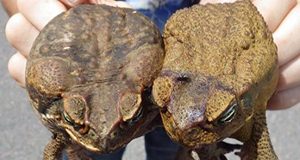El sapo de caña (Rhinella marina), a veces conocido como el “bufo”, sapo gigante o marino, es nativo del extremo sur de Texas, México, América Central y la zona tropical de la América del Sur, pero está establecido en Florida. Los sapos de caña se introdujeron inicialmente en Florida como un método de control biológico de plagas en la década de 1930. Se suponía que los sapos comieran escarabajos que amenazaran el cultivo de la caña de azúcar, pero la población introducida no sobrevivió. This 7-page fact sheet written by S. A. Johnson, A. Wilson, and Armando J. Ubeda and published by the UF/IFAS Department of Wildlife Ecology and Conservation is the Spanish translation of The Cane or “Bufo” Toad (Rhinella marina) in Florida.
https:edis.ifas.ufl.edu/uw477
Tag: S. A. Johnson
History and Status of Introduced Rhesus Macaques (Macaca mulatta) in Silver Springs State Park, Florida
Local folklore suggests that the rhesus macaque monkeys living in what is today Silver Springs State Park were released while the 1939 movie Tarzan "Finds a Son" was filmed at the site, but no rhesus macaques appear in that movie, and the macaques had been living in Silver Springs for a considerable time before Tarzan found his son there. In fact, today’s thriving population of macaques in Silver Springs State Park descended from monkeys intentionally released earlier in the 1930s in an effort to increase tourism to the area.
Silver Springs became a tourist attraction in the 1870s and has had glass-bottom boat tours ever since. In the 1930s the manager of the glass bottom boat operation, Colonel Tooey, released approximately six rhesus macaques to attract tourists and increase revenue for the boat tours. Not knowing rhesus macaques are proficient swimmers, Colonel Tooey released his monkeys on an island in the Silver River from whence they quickly swam to the surrounding forests, where they made themselves at home and set up a growing colony. What happened next? Learn the story (so far!) of the monkeys and the park in this 4-page fact sheet written by C. J. Anderson, S. A. Johnson, M. E. Hostetler, and M. G. Summers and published by the Department of Wildlife Ecology and Conservation.
edis.ifas.ufl.edu/uw412

